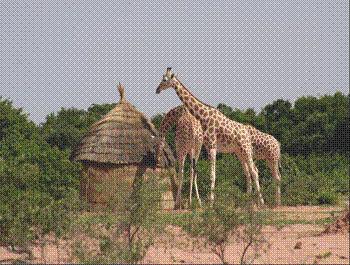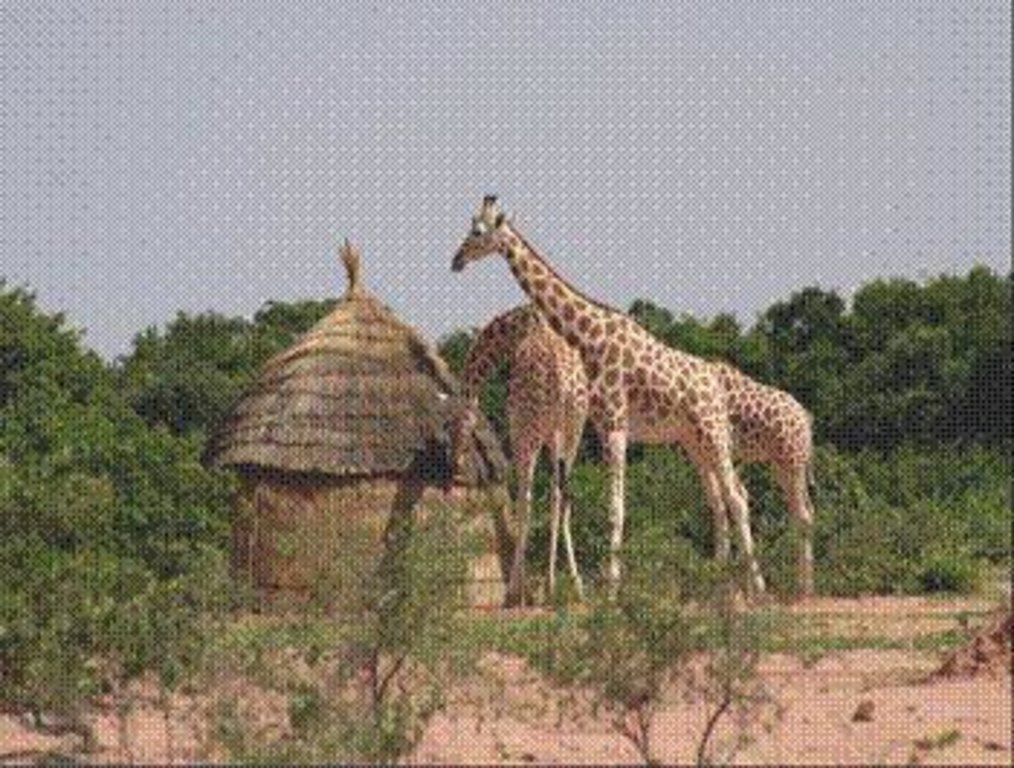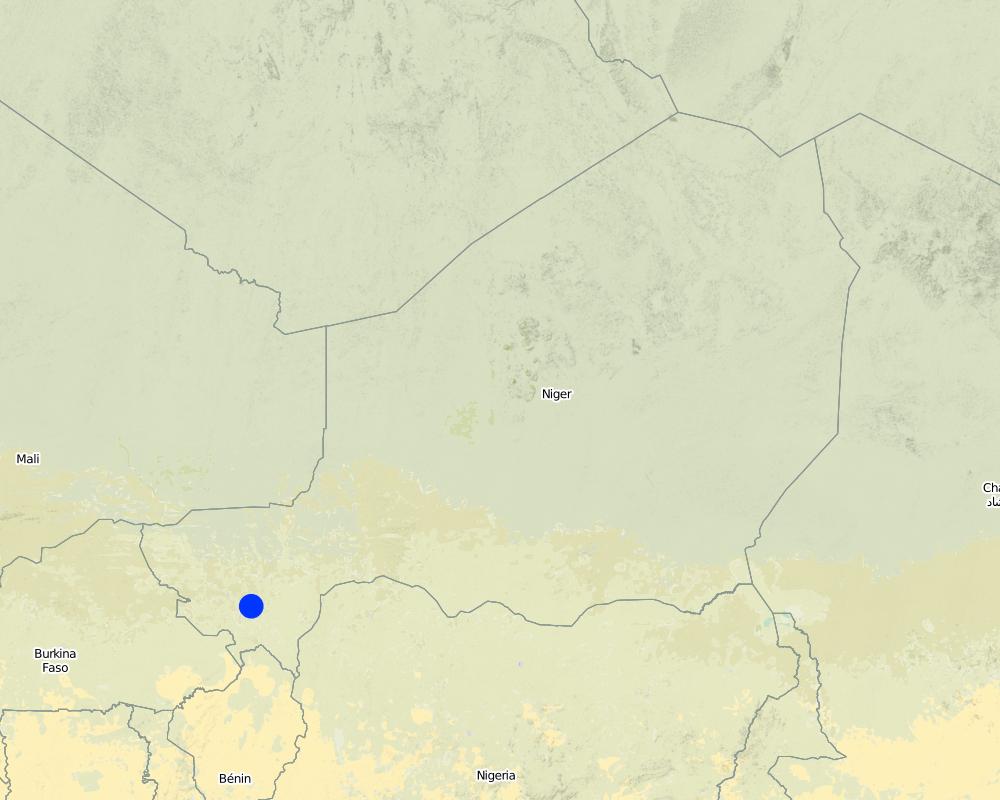Conservation Approach for Kouré Giraffes [Níger]
- Criação:
- Atualização:
- Compilador/a: Soumaila Abdoulaye
- Editor: –
- Revisor: Fabian Ottiger
approaches_2568 - Níger
Veja as seções
Expandir tudo Recolher tudo1. Informação geral
1.2 Detalhes do contato das pessoas capacitadas e instituições envolvidas na avaliação e documentação da abordagem
Especialista em GST:
Oumarou Ahmed
Ministry of Environment, Niger
Níger
Nome da(s) instituição(ões) que facilitou(ram) a documentação/avaliação da Abordagem (se relevante)
GREAD (GREAD) - NígerNome da(s) instituição(ões) que facilitou(ram) a documentação/avaliação da Abordagem (se relevante)
Ministry of Environment and Sustainable Development of Niger (MINEDD) - Níger1.3 Condições em relação ao uso da informação documentada através de WOCAT
O/a compilador/a e a(s) pessoa(s) capacitada(s) aceitam as condições relativas ao uso de dados documentados através da WOCAT:
Sim
2. Descrição da abordagem de GST
2.1 Descrição curta da abordagem
This participatory approach to protect the last population of white giraffes actively involves local people in conservation activities, while simultaneously strengthening local development and promoting ecotourism.
2.2 Descrição detalhada da abordagem
Descrição detalhada da abordagem:
Aims / objectives: The giraffe population in Kouré, Niger is unique because: (1) it includes the last representatives of white giraffes (Giraffa camelopardalis peralta) worldwide; (2) it thrives in an unprotected environment without any natural enemy (besides man); (3) it is in direct contact with rural communities and its livestock. The giraffe, reduced to only 49 individuals in 1996, was in danger of extinction due to a variety of reasons, the main one being the progressive deforestation in their habitat: the brousse tigré savannah vegetation. From 1996-2000, a government programme funded by international development agencies (SNV*, FFEM and the EU) has been carried out to sustainably protect the giraffes and their habitat. This program is based on a participatory approach which actively involves local people in conservation activities, while simultaneously strengthening local development and promoting ecotourism. Its revenues are redistributed to all local actors. A main pillar of the approach was the transfer of responsibilities in natural resources management to local organizations. User groups, a guides’ association, a project steering committee, etc. were formed and its members were trained.
Methods: Tourism and wildlife observation infrastructure was established – including a visitor’s centre, lodging, watch towers, etc – and tourism activities were organized: Guides are trained, registered and organized into an association. They receive a fixed salary and accompany tourists in turns. Furthermore they support project technicians and researchers in monitoring giraffes and collaborate with the network of government-employed foresters, which has been set up to control the conservation of the habitat. Tourists pay an entry fee for wildlife watching tours. The revenues and donations are partly used for management and conservation of the giraffe habitat and partly for socio-economic development of the villages (such as infrastructure projects). These revenues are managed directly by the ‘communes’ (municipalities).
Other important information: Thanks to the protection of the savannah vegetation through enclosures for regeneration, prohibition of cutting and closing down of rural wood markets the giraffe population has recovered considerably, comprising 200 individuals in 2008.
2.3 Fotos da abordagem
2.5 País/região/locais onde a abordagem foi aplicada
País:
Níger
Região/Estado/Província:
Tillabéri / Dosso
Especificação adicional de localização:
Kouré
Map
×2.6 Datas de início e término da abordagem
Indique o ano de início:
1996
Ano de término (caso a abordagem não seja mais aplicada):
2000
2.7 Tipo de abordagem
- Baseado em projeto/programa
2.8 Principais metas/objetivos da abordagem
The Approach focused mainly on SLM with other activities (health, education, infrastructure, trade, micro-credit, river works, forest surveillance)
Durable and sustainable conservation of the giraffe population in the Kouré area and protection of their habitat; Building organizational and management capacity of the local population for protecting the giraffes; Fight against poverty by offering supplementary revenue to population through ecotourism (diversification of income).
The SLM Approach addressed the following problems: Conflicts between giraffes and local population (damage to crops); Extinction of giraffes; Deforestation (giraffe habitat deterioration); Rural Poverty; Negative perception of fauna by the population; Absence of titled land ownership and of adapted forestry laws
3. Participação e papel das partes interessadas envolvidas
3.1 Partes interessadas envolvidas na abordagem e seus papéis
- Usuários de terra/comunidades locais
Women were also involved
- Governo local
- Governo nacional (planejadores, responsáveis pelas decisões)
- Organização internacional
3.2 Envolvimento do usuários de terra/comunidades locais nas diferentes fases da abordagem
| Envolvimento do usuários de terra/comunidades locais | Especifique quem estava envolvido e descreva as atividades | |
|---|---|---|
| Iniciação/motivação | Nenhum | Ministries of planning, environment, tourism and artisan, EU, Association of French Volunteers for Progress (AFVP), SNV, beneficiaries. |
| Planejamento | Participativo | Kouré Guides Association (AGK), groups of beneficiaries, project advisors and animators |
| Implementação | Participativo | Kouré Guides Association (AGK), groups of beneficiaries, project advisors and animators |
| Monitoramento/avaliação | Participativo | AGK, groups of beneficiaries, project advisors and animators, department of Environmental Protection |
| Research | Nenhum | French Center for Agricultural Research for Development (CIRAD), University of Niamey, National Agricultural Research Institute of Niger (INRAN), International Union for Conservation of Nature (IUCN) and the International Crops Research Institute for the Semi-Arid Tropics (ICRISAT) |
3.4 Decisão sobre a seleção de tecnologia/tecnologias de GST
Especifique quem decidiu sobre a seleção de tecnologia/tecnologias a serem implementadas:
- Políticos/líderes
Explique:
Initiation by the Ministries of planning, environment, tourism and artisan, EU, Association of French Volunteers for Progress (AFVP), SNV, beneficiaries
4. Suporte técnico, reforço das capacidades e gestão do conhecimento
4.1 Reforço das capacidades/ formação
Foi oferecida formação aos usuários da terra/outras partes interessadas?
Sim
Especifique quem foi capacitado:
- Usuários de terra
- Equipe de campo/consultores
Caso seja relevante, especifique gênero, idade, status, etnia, etc.
members of community management committee, land users (women and men), professional guides, advisors
Tipo de formação:
- Em exercício
- Agricultor para agricultor
- Áreas de demonstração
- Reuniões públicas
- Cursos
Assuntos abordados:
Conservation technologies and SLM, ecotourism, professional guide skills, organization of associations, accountancy, agriculture
4.2 Serviço de consultoria
Os usuários de terra têm acesso a um serviço de consultoria?
Sim
Especifique se foi oferecido serviço de consultoria:
- nas áreas dos usuários da terra
Descreva/comentários:
Name of method used for advisory service: Dissemination of the approach was by rural animation tools (village planning, rapid PRA, etc.).; The Youth Association for Preservation of Natural Resources (AJPREN), U.S. Peace Corps, AFVP and local departments for Environmental Protection ensured a continuous programme of training, environmental education and awareness raising of guides and local people.
4.5 Pesquisa
A pesquisa foi parte da abordagem?
Sim
Especifique os tópicos:
- Sociologia
- Economia/Marketing
- Ecologia
Dê mais detalhes e indique quem realizou a pesquisa:
Research had been conducted on-farm in collaboration with local populations. Research topics treated were socio- economical, ecological, technical, giraffe habitat and genetics and agricultural.
Research was carried out on-farm
5. Financiamento e apoio material externo
5.1 Orçamento anual para o componente de GST da abordagem
Caso o orçamento exato seja desconhecido, indique a faixa:
- 100.000-1.000.000
Comentários (p. ex. principais fontes de recursos/principais doadores):
Approach costs were met by the following donors: international (EU, SNV, FFEM): 100.0%
5.2 Apoio financeiro/material concedido aos usuários da terra
Os usuários da terra receberam apoio financeiro/material para a implementação de tecnologia/tecnologias?
Sim
5.3 Subsídios para entradas específicas (incluindo mão-de-obra)
- Equipamento
| Especifique quais entradas foram subsidiadas | Em que medida | Especifique os subsídios |
|---|---|---|
| Maquinário | Totalmente financiado | |
| Ferramentas | Totalmente financiado | |
- Agrícola
| Especifique quais entradas foram subsidiadas | Em que medida | Especifique os subsídios |
|---|---|---|
| Sementes | Totalmente financiado | |
| Fertilizantes | Totalmente financiado | |
- Infraestrutura
| Especifique quais entradas foram subsidiadas | Em que medida | Especifique os subsídios |
|---|---|---|
| Tourism | Totalmente financiado | |
- Outro
| Outros (especifique) | Em que medida | Especifique os subsídios |
|---|---|---|
| Village development funds and Giraffe habitat management | Totalmente financiado |
Se a mão-de-obra pelos usuários da terra foi uma entrada substancial, isso foi:
- Voluntário
5.4 Crédito
Foi concedido crédito segundo a abordagem para atividades de GST?
Sim
Especifique as condições (taxa de juros, reembolso, etc):
repayment conditions: Through village development fund; micro-credit was allocated without interest to women of women groups for agriculture or livestock production. Repayment occurred after six months. After termination of the project, ‘Care International’ continued giving credit however with interest..
6. Análise de impactos e declarações finais
6.1 Impactos da abordagem
A abordagem auxiliou os usuários da terra a implementar e manter as tecnologias de GST?
- Não
- Sim, pouco
- Sim, moderadamente
- Sim, significativamente
Improved sustainable land management: one director for the planning and management of the giraffe area was appointed.
A abordagem concedeu autonomia aos grupos social e economicamente desfavorecidos?
- Não
- Sim, pouco
- Sim, moderadamente
- Sim, significativamente
financial support to women for agricultural production
Did other land users / projects adopt the Approach?
- Não
- Sim, pouco
- Sim, moderadamente
- Sim, significativamente
Adoption of Approach by other land users / projects: the ECOsystèmes Protégés en Afrique Sahélienne (ECOPAS) project adopted (2002) this approach which became the basis for national planning action for giraffes in Niger.
Did the Approach lead to improved livelihoods / human well-being?
- Não
- Sim, pouco
- Sim, moderadamente
- Sim, significativamente
3811 Euros/village had been distributed to the population of 20 villages through village development funds
Did the Approach help to alleviate poverty?
- Não
- Sim, pouco
- Sim, moderadamente
- Sim, significativamente
creation of 13 permanent guide jobs; 900 woman developed agriculture production for marketing
6.2 Principal motivação dos usuários da terra para implementar a GST
- Lucro (lucrabilidade) aumentado, melhora da relação custo-benefício
- Pagamentos/subsídios
- well-being and livelihoods improvement
6.3 Atividades de sustentabilidade de abordagem
Os usuários da terra podem manter o que foi implementado através da abordagem (sem apoio externo)?
- Sim
Caso afirmativo, descreva como:
After the project was terminated, land users continued this approach without external support based on local development organizations, Association pour la Sauvegarde des Giraffes du Niger (ASGN) and Kouré Guides Association (AGK). Since 2002, the research component is being continued by ECOPAS / EU.
6.4 Pontos fortes/vantagens da abordagem
| Pontos fortes/vantagens/oportunidades na visão do/a compilador/a ou de outra pessoa capacitada |
|---|
| Populations organization and mobilization |
| Scientific research tools for decision making |
| Economic, financial and ecological impacts |
6.5 Pontos fracos, desvantagens da tecnologia e formas de superá-los
| Pontos fracos/vantagens/riscos na visão do/a compilador/a ou de outra pessoa capacitada | Como eles podem ser superados? |
|---|---|
| Absence of local and national financial contribution | provide regressive grants and promote endogenous funding of activities |
| Uncontrolled fast growth of giraffe population | transfer of giraffes to other protected habitats in West Africa. |
| Approach resulted from exterior initiatives | awareness raising and environmental education to develop ‘conservation behaviour’ in Niger |
7. Referências e links
7.1 Métodos/fontes de informação
- visitas de campo, pesquisas de campo
- entrevistas com usuários de terras
7.2 Referências às publicações disponíveis
Título, autor, ano, ISBN:
Oumarou A. 2006. Elaboration d’une stratégie de conservation à long terme de la girafe au Niger, communication à l’atelier sur les girafes du Niger organisé du 22-24 novembre 2006 à Niamey (Niger) par le Ministère de l’environnement et de la lutte contre la désertification en partenariat avec ECOPAS/Union EuropéenneCompte rendu de l’atelier international sur la cogestion faune sauvage et bétail, organisé par Abdoulaye Sambo Soumaila et Marlis Lindecke, DED Niger et GTZ Eschborn, février 2001
Título, autor, ano, ISBN:
Compte rendu de l’atelier international sur la cogestion faune sauvage et bétail, organisé par Abdoulaye Sambo Soumaila et Marlis Lindecke, DED Niger et GTZ Eschborn, février 2001
Links e módulos
Expandir tudo Recolher tudoLinks
Não há links
Módulos
Não há módulos





